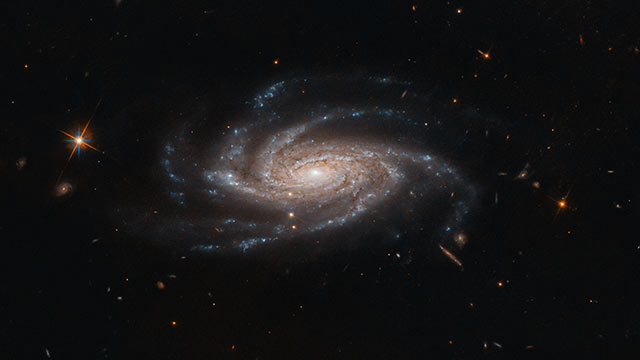Using deep-space imaging from NASA’s Hubble Space Telescope, an international team of astronomers has discovered that some peculiar, short-lived phenomena have an even more peculiar home.
In a new study, the team including Northwestern University astrophysicists traced the locations of eight fast radio bursts (FRBs), discovering that five resided within spiral galaxies — right along the galaxies’ curvy outstretched arms. This new and surprising information will help researchers determine what astronomical events trigger such brief, intense flashes of light, narrowing down the search of possible sources.

“We don’t know what causes FRBs, so it’s really important to use context when we have it,” said Northwestern’s Wen-fai Fong, a co-author of the study. “Because spiral arms are signs of stars being born, this was a surprise, offering a major clue that FRBs must correlate with star formation.”
“This is the first high-resolution view of a population of FRBs,” said Alexandra Mannings, the study’s lead author. “Most of the galaxies are massive, relatively young and still forming stars. The imaging allows us to get a better idea of the overall host galaxy properties, such as its mass and star-formation rate, as well as probe what’s happening right at the FRB position.”
The research has been accepted and soon will publish in The Astrophysical Journal.
Fong is an assistant professor of physics and astronomy in Northwestern’s Weinberg College of Arts and Sciences and a member of CIERA (Center for Interdisciplinary Exploration and Research in Astrophysics). Mannings is a graduate student in astronomy and astrophysics at the University of California, Santa Cruz. Fong advised Mannings as a part of the Fast and Fortunate for FRB Follow-up team, a collaboration that observes the locations of FRBs at a multitude of wavelengths. In this current study, the team used various types of imaging techniques to trace FRBs to their host galaxies.
Fast and furious
Flaring and disappearing within milliseconds, FRBs are brief, powerful radio blasts that generate more energy than our sun does in an entire year. Although astronomers have uncovered up to 1,000 FRBs since discovering them in 2007, they have only been able to trace about 15 FRBs to specific galaxies — all fairly young and massive — far from Earth. After that, the trail runs cold.
In the new study, Fong, Mannings and their collaborators combined ultraviolet and near-infrared imaging with visible images from Hubble’s Wide Field Camera 3, in order to trace eight FRBs to their exact neighborhoods. The resulting images displayed five FRBs residing within spiral galaxies, right along the galaxies’ winding arms — but not within the arms’ brightest regions, which blaze with light from the youngest, most massive stars. (The positions of the other three FRBs are still inconclusive.) Although FRBs are connected to star formation, they do not originate from the youngest, most massive stars.
“This puts it in a ‘Goldilocks’ situation,” Fong said. “We definitely know FRBs are correlated with active star formation, which signifies young source stars. But now we know they do not come from the youngest, most massive stars. So the stars cannot be too young or too old.”
Maybe a magnetar?
These new clues helped researchers rule out several possible sources as the dominant origin of FRBs, including neutron star mergers and the explosive deaths of young stars, which generate gamma-ray bursts. Instead, now researchers believe FRBs could originate from magnetar outbursts. A type of supermassive neutron star, magnetars possess a magnetic field 10 trillion times more powerful than a refrigerator door magnet. Last year, astronomers linked observations of an FRB in our Milky Way with a region where a known magnetar resides.
“Owing to their strong magnetic fields, magnetars are quite unpredictable,” Fong said. “In this case, the FRBs are thought to come from flares from a young magnetar. Massive stars go through stellar evolution and become neutron stars, some of which can be strongly magnetized, leading to flares and magnetic processes on their surfaces, which can emit radio light. Our study fits with that ‘Goldilocks’ scenario, ruling out either very young or very old progenitors for FRBs.”
As new radio facilities discover more and more FRBs with precise locations, Fong is interested to learn whether all FRBs will be traced to spiral galaxies or if astronomers will uncover a more diverse range of origins. “It’s a really new, exciting field with limited observations,” she said. “We’re paving the way to learning more about this cosmic mystery.”
The study, “A high-resolution view of fast radio burst host environments,” was supported by the National Science Foundation (NSF) and NASA. Fong recently received an NSF CAREER award, which will help support her future work in this area.


